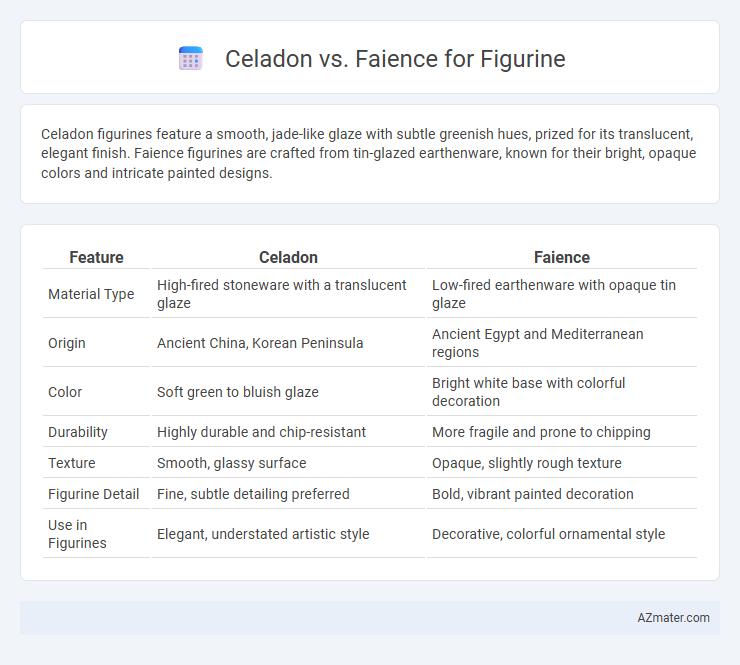Celadon figurines feature a smooth, jade-like glaze with subtle greenish hues, prized for its translucent, elegant finish. Faience figurines are crafted from tin-glazed earthenware, known for their bright, opaque colors and intricate painted designs.
Table of Comparison
| Feature | Celadon | Faience |
|---|---|---|
| Material Type | High-fired stoneware with a translucent glaze | Low-fired earthenware with opaque tin glaze |
| Origin | Ancient China, Korean Peninsula | Ancient Egypt and Mediterranean regions |
| Color | Soft green to bluish glaze | Bright white base with colorful decoration |
| Durability | Highly durable and chip-resistant | More fragile and prone to chipping |
| Texture | Smooth, glassy surface | Opaque, slightly rough texture |
| Figurine Detail | Fine, subtle detailing preferred | Bold, vibrant painted decoration |
| Use in Figurines | Elegant, understated artistic style | Decorative, colorful ornamental style |
Introduction to Celadon and Faience Figurines
Celadon figurines are renowned for their distinctive jade-green glaze, which originates from ancient East Asian pottery techniques, offering a smooth, translucent surface that enhances the delicate details of the sculpture. Faience figurines, by contrast, are characterized by their tin-glazed earthenware composition, producing a bright, opaque finish often decorated with vibrant colors and intricate patterns rooted in Mediterranean and Egyptian traditions. These two styles represent unique cultural heritages and firing processes, influencing their texture, color palette, and decorative appeal in ceramic art.
Historical Origins of Celadon and Faience
Celadon ceramics originated during the Eastern Han Dynasty in China around the 2nd century AD, renowned for their jade-like glaze and subtle greenish hues achieved through iron oxide in the firing process. Faience, in contrast, traces back to ancient Egypt around 4000 BCE, characterized by its bright turquoise-blue glaze created from ground quartz and copper compounds, often used for amulets and small figurines. Both materials reflect distinct cultural and technological advancements, with celadon emphasizing refined elegance in East Asian pottery and faience representing early innovations in glazed artisan crafts.
Distinctive Production Techniques
Celadon figurines are characterized by their unique glaze technique, which involves applying a transparent, pale green glaze produced by iron oxide and fired in a reduction kiln, creating a smooth, jade-like surface. Faience figurines employ an intricate tin-glazed pottery method, resulting in an opaque, glossy surface with vibrant, often multicolored decorations achieved through painted motifs on the glaze. The distinct firing processes and chemical compositions in celadon and faience production directly influence their texture, color palette, and overall aesthetic, making each technique uniquely identifiable.
Material Composition and Glazing Styles
Celadon figurines are crafted from high-quality porcelain or stoneware clay, featuring a translucent glaze with subtle green to blue hues derived from iron oxide firing in a reduction kiln. Faience figurines use earthenware clay with a lead-based opaque glaze that often showcases vibrant colors and a glossy surface due to the tin oxide opacification. The smooth, glass-like finish of celadon contrasts with faience's brightly colored, slightly textured glaze, reflecting distinct cultural and technical origins in ceramic artistry.
Color Palette and Aesthetic Appeal
Celadon figurines showcase a distinctive pale green to blue-gray color palette achieved through iron oxide glaze, lending a serene and understated elegance to each piece. Faience figurines feature a vibrant array of colors from turquoise and cobalt blue to bright yellows, created by tin-glazed earthenware, resulting in a more vivid and decorative appearance. The subtle, muted tones of celadon contrast with the bold, glossy finish of faience, influencing collectors' preferences based on either minimalist sophistication or striking ornamental appeal.
Durability and Preservation Over Time
Celadon figurines exhibit superior durability due to their dense, high-fired stoneware composition, which resists chipping and cracking better than fragile faience, a type of low-fired, porous earthenware. The glazed surface of celadon provides excellent preservation qualities, protecting sculptures from moisture and environmental damage over time, whereas faience's glaze is more prone to crazing and deterioration. Consequently, celadon is preferred for long-term preservation of figurines, especially in varying climatic conditions.
Popular Regions and Cultural Significance
Celadon figurines are highly prized in East Asia, particularly in Korea and China, where the distinct jade-green glaze symbolizes harmony and spirituality. Faience, originating from ancient Egypt and flourishing in the Mediterranean, is renowned for its bright blue and turquoise glazes representing protection and fertility in their cultures. Collectors value both materials not only for their aesthetic qualities but also for their deep-rooted cultural narratives reflecting regional histories and religious beliefs.
Notable Figurine Examples in Art History
Celadon figurines, renowned for their serene, jade-like glaze, include notable examples such as the Korean Goryeo Dynasty Buddhist sculptures showcasing exquisite craftsmanship and subtle green hues. Faience figurines, often vibrant and glossy, prominently appear in Ancient Egyptian art, like the iconic shabti statuettes crafted to serve the deceased in the afterlife, reflecting the material's symbolic and ritual significance. Both mediums demonstrate distinct cultural values and aesthetic qualities, with celadon emphasizing calm elegance, while faience highlights colorful durability and spiritual symbolism.
Collector Value and Market Trends
Celadon figurines, prized for their distinctive jade-green glaze and origins in East Asian artistry, typically command higher collector value due to their rarity and historical significance. Faience figurines, characterized by tin-glazed earthenware with vibrant colors originating from European traditions, appeal to collectors interested in decorative and folk art but generally fetch lower prices in the market. Market trends indicate a steady appreciation in celadon pieces driven by increasing demand from Asian art collectors, while faience maintains stable but modest interest among niche vintage and decorative art enthusiasts.
Choosing Between Celadon and Faience for Figurines
Choosing between celadon and faience for figurines depends on the desired aesthetic and historical context. Celadon offers a translucent, jade-like glaze with subtle green hues ideal for East Asian-inspired designs, while faience provides a glossy, opaque surface in vibrant colors associated with ancient Egyptian and Mediterranean art. Consider the figurine's style, desired color palette, and cultural significance to select the material that best enhances artistic expression.

Infographic: Celadon vs Faience for Figurine
 azmater.com
azmater.com